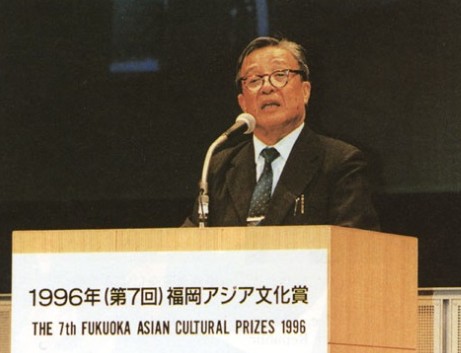Wang Zhongshu
From:CSSN NetWriter:Date:2015-03-28
Original title: Wang Zhongshu:studying archaeology transcending boundaries (The Chinese version appeared in Chinese Social Sciences Today, No. 476, July 17th, 2013)

Professor Wang gave a speech in Japan in 1996
“Professor Wang Zhongshu is one of Asia's most prominent archaeologists. He has been instrumental to the establishment and development of archaeology in China. Furthermore, the outstanding achievements made by Professor Wang in the field of ancient Sino-Japanese relations have had a great impact on the study of international exchange in Asia. His legacy in increasing awareness around the world of the importance of Chinese and Asian culture is a great one. ” So read the citation of the Fukuoka Asian Culture Prize awarded to him in 1996, an award shared by figures such as the famous author Ba Jin and sociologist Fei Xiaotong before him.
Wang Zhongshu is a prominent Chinese archaeologist. In addition to Chinese archaeology, his interest extends to Japanese archaeology and ancient Japanese history.
Recently, I interviewed 88-year-old Wang Zhongshu at CASS. Through conversation, I learned that he still comes to the office twice a week, reading books, collating materials and writing manuscripts. He anticipates publishing several extensive works in the near future, including Collected Works of Wang Zhongshu (in four volumes of roughly 400,000 words each), Han Civilization (a 500,000 word work appearing in both Chinese and English) and Ancient China’s Relations with Japan and Nations on the Korean Peninsula (a collection of articles totaling about 250 ,000 words).
Born in 1925, Wang graduated from Peking University with a degree in history in 1950. After graduating, he began working for the Institute of Archaeology at the Chinese Academy of Sciences (now an institute in the Chinese Academy of Social Sciences), where he served in turn as the institute’s deputy director, director, and director of its academic committee. In 2006, he was awarded honorary membership in the Chinese Academy of Social Sciences. He is also a corresponding member of the German Archeological Institute and a fellow at the Institute of Okinawan Studies.
Wang’s career-long devotion to the excavation and investigation of important relics has taken him geographically across China and even to Japan, and historically from the Warring States Period and Qin and Han Dynasties to the Sui and Tang Dynasties. His tremendous achievements are far ranging, including significant research on artifacts of the capital cities of ancient states, burial practices and systems, and lacquerware and bronze mirrors. With his broad view, extensive knowledge and unique interpretation, he has been able to shed light on many important academic problems in the field of Japanese archaeology and ancient Japanese history.
Because of his expertise in Han and Tang history, he has been well poised to understand how deeply the culture of these dynasties impacted regions beyond China during their respective heydays. During these periods, China led the world in many ways. By land and by sea, China had frequent contact with other societies throughout Asia, especially on the Japanese Archipelago, on the Korean Peninsula, and in Central and Western Asia. It even had contact with some European countries, truly exerting an international influence. Given how far its influence spread, the archaeological investigation of relics and remains from the Han and Tang Dynasties is vital not only for Chinese archaeology, but also archaeology worldwide.
Wang Zhongshu has also made significant contributions to Japanese archaeology and research on ancient Japanese history. For Wang, the close connection between Han and Tang archaeology to Japanese archaeology and ancient Japanese history is self-evident; archaeological research on ancient Japan would be almost impossible without knowledge of Chinese archaeology and ancient Chinese history. This has prompted substantial efforts on the part of many Japanese archeologists to familiarize themselves with Chinese archeology, in some cases making substantial discoveries. Likewise, Chinese archeologists cannot fully study the Han and Tang Dynasties without awareness of Japanese archaeology and ancient Japanese history—unaware of Han and Tang influence on Japan, they would not understand these dynasties’ impact outside of ancient China.
Over the course of his six decades career, Wang Zhongshu has published many books influential both in China and the world, including A Brief Introduction to Han Archaeology (1984), “Deity and Beast” Triangular—rimmed Bronze Mirrors (in Japanese, 1992), Ancient Japan Seen from China (in Japanese, 1992) and Chinese and Japanese Archaeology: Collection of Essays on Ancient History, among others.
There is a wealth of material in Chinese archaeology, spanning many millennia. Chinese archeologists research the Paleolithic Age, the Neolithic age, and the many dynasties—the Xia and Shang Dynasties, the Zhou Dynasty, Qin and Han Dynasties, Wei, Jin and the Southern and Northern Dynasties, Sui and Tang Dynasties, and the Song, Liao, Jin, Yuan and Ming Dynasties. While each period has its own significance and characteristics, they each present a common issue for researchers: archeologists investigating each period must also examine China’s exchange with other parts of the world during that period. Although simultaneously conducting comprehensive research on world history while doing archaeological investigation and research in China is difficult, it is necessary to foster talent who can conduct archaeological research in other countries. Wang Zhongshu has great hopes for China’s junior archaeologists. He advised that “archaeological investigation and excavation must be accompanied by historical literature, and Chinese archaeological research needs to be in line with world archaeology.”

